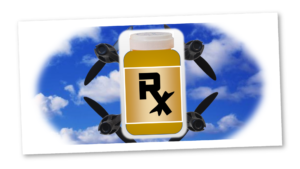Look to the Skies

A lack of demand queue resilience places extra emphasis on developing alternative delivery mechanisms for outpatient pharmacy product.
I searched the ceilings, walls, utility hallways, and even the skies looking for solutions to an efficient and functional outpatient pharmacy hub. This hospital, like many others, needed to control cost-to-fill while addressing leakage through the many patient egress points. What to do …
Hospitals use tube systems to move product to delivery points through-out the hospital. New hospitals may have anticipated the need for such systems. Even so, I have not come across a hospital that considered the needs of the outpatient pharmacy at design time. Retrofitting new and older hospitals with suitable outpatient pharmacy tube delivery systems can be costly (although I would argue not as costly as leakage).
In this instance, from the outpatient pharmacy window I could see one of my objectives 200 yards directly across the maze of roads and gardens leading to the main entrance. This was clearly the most direct path. But, navigating the busy walkways might be problematic both from logistic and pedestrian points of view. If only we could fly there. Drone?
Technical.ly Baltimore reported that on April 19th, UMMC successfully received a transplant organ by drone. That drone was costly and sophisticated, far more than what would carry a small package 200 yards below building height across possibly uncontrolled airspace. The low cost and logistic advantage for drop-ship drones make these a clear alternative to more costly alternatives. Moreover, computer-controlled drones might service multiple delivery points across an entire hospital campus.
The successful outpatient pharmacy must be delivery-centric, meaning prescriptions are available on-demand, they must also be available wherever the demand presents itself. Whether drones are the answer, or in combination with carts, Segway, or tube systems, hospitals must offer on-demand patient prescription pick-up points throughout their market, the hospital and campus.
Florida’s consideration of efforts to redefine ‘direct pharmacist supervision’ clearly points to a future when retailers position supervising pharmacists at retail hubs. Relaxing the current definition of supervision would address the costly architecture of fully staffing all market delivery points. Independent drug stores that survived by virtual of their lower market opportunity would no longer be protected by the high prescription per day threshold of chain drug stores.
There are three messages here. First, outpatient pharmacies must begin to think of themselves as a solution rather than retail clones or an extension thereof. The highly engineered cost-efficient filling operations of drug chains do not satisfy the challenges of a hospital market or patients. Second, retailers are working to relax retail-biased regulations that block technologies and operations previously too costly for them to adopt. Third, hospital outpatient pharmacies are the only viable patient-centric and therapeutic outcome solution for healthcare … with the potential to compete with drug chains.
Hospitals must envision their future or be a part of someone else’s future.